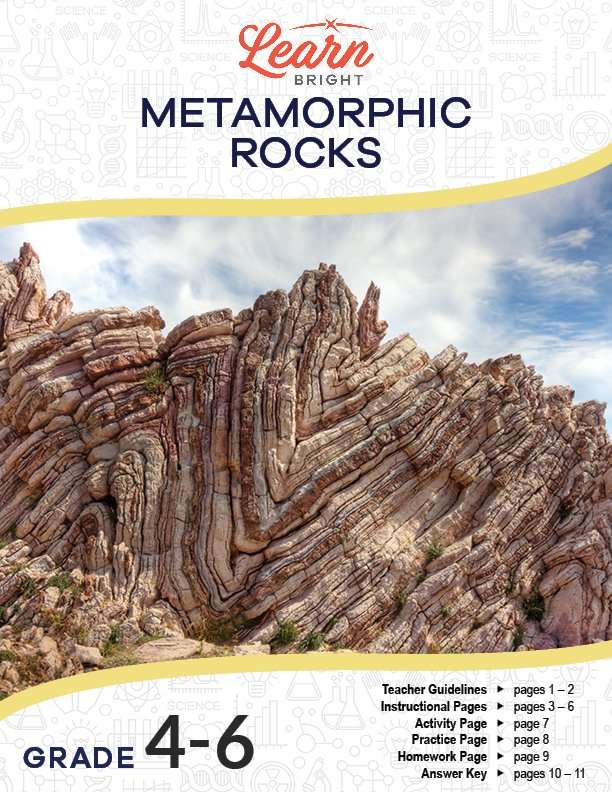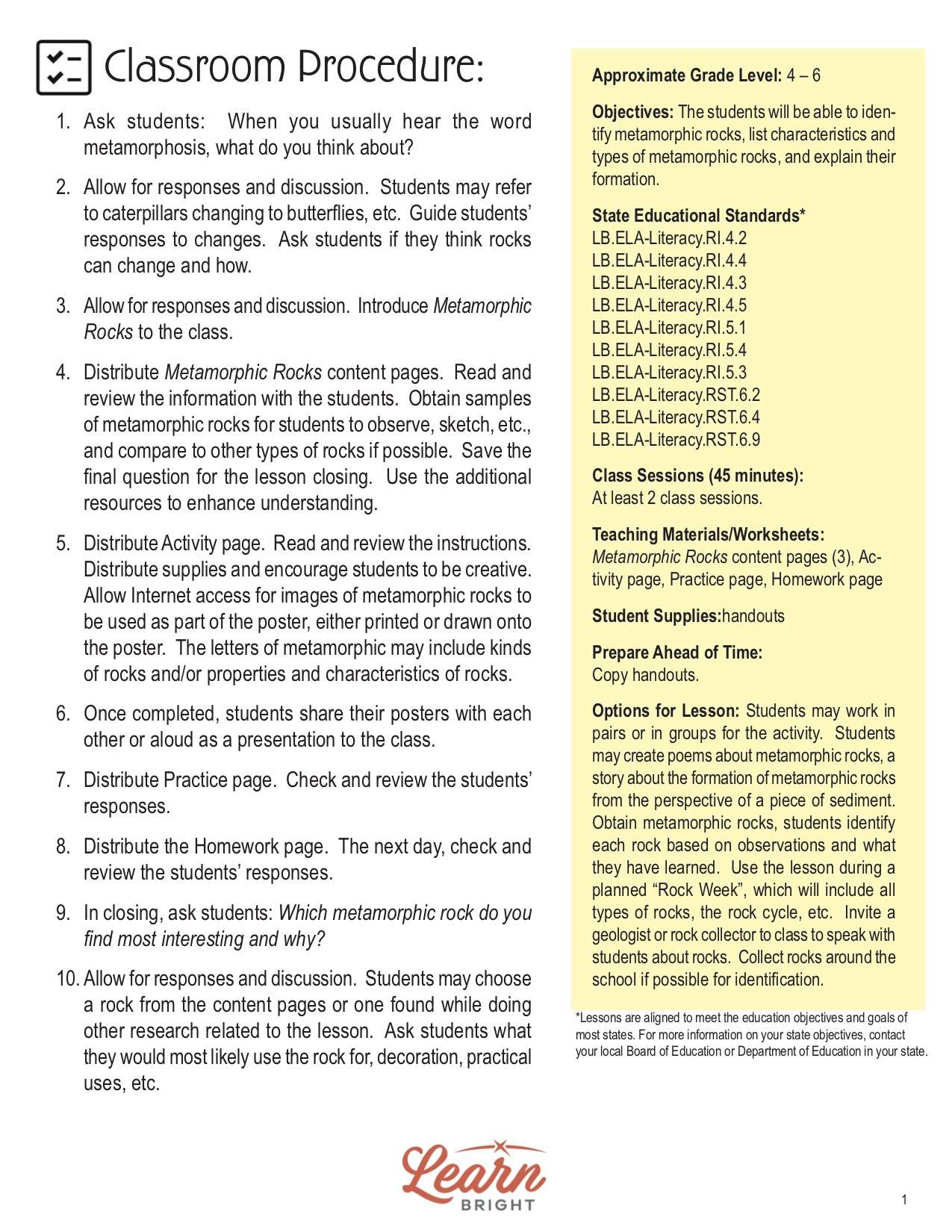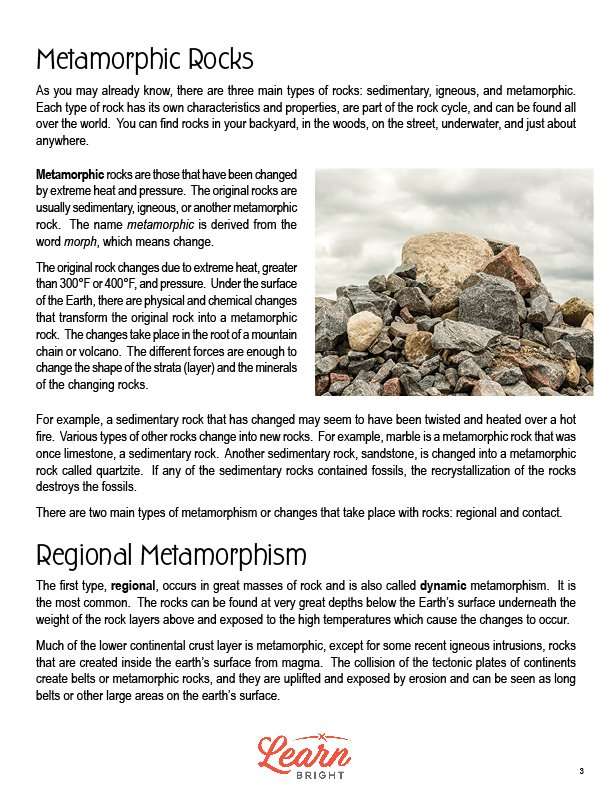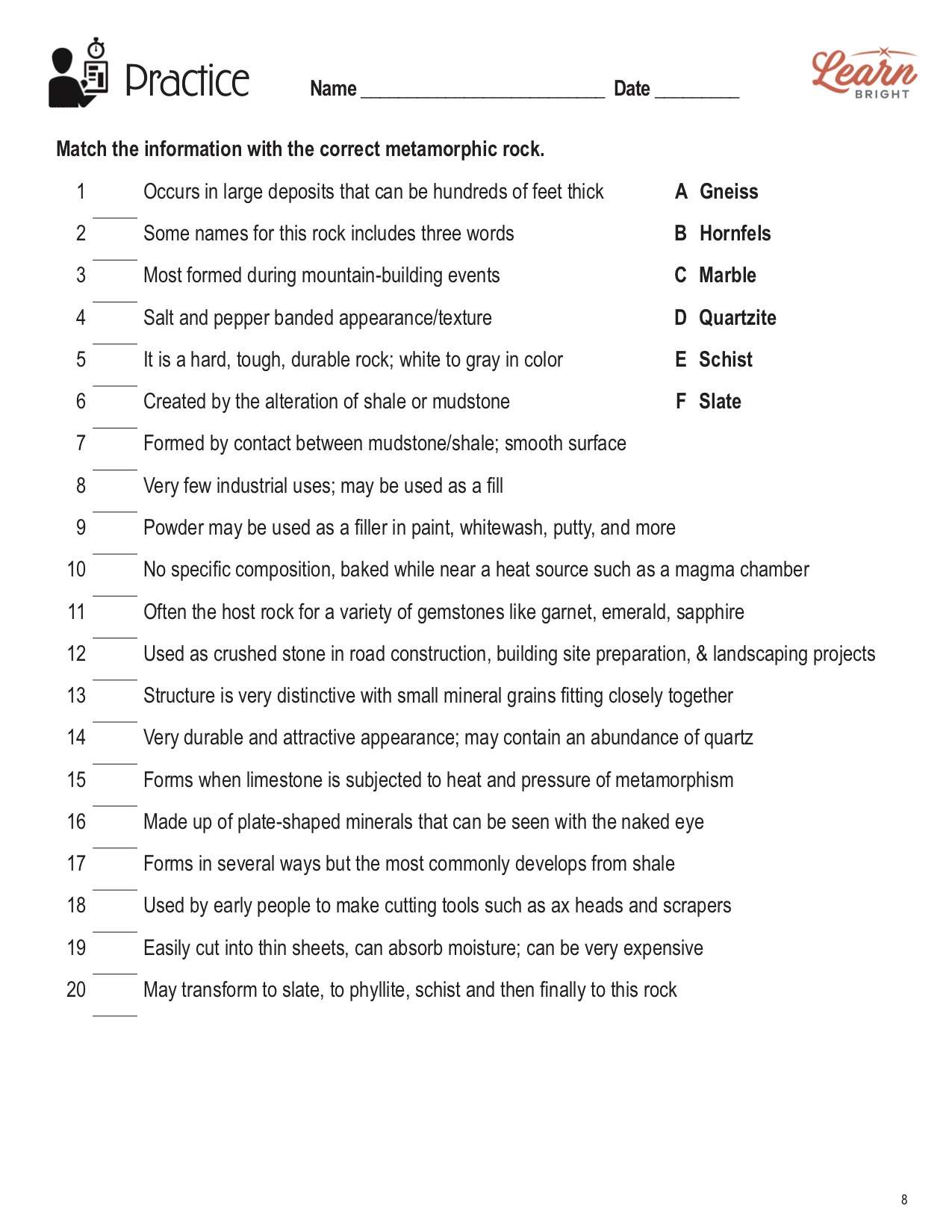Description
What our Metamorphic Rocks lesson plan includes
Lesson Objectives and Overview: Metamorphic Rocks outlines some of the traits and types of rock that fall into this category. Students will learn about these traits and will be able to list them correctly. They will learn how to identify these rocks and explain how they formed in the rock cycle. This lesson is for students in 4th grade, 5th grade, and 6th grade.
Classroom Procedure
Every lesson plan provides you with a classroom procedure page that outlines a step-by-step guide to follow. You do not have to follow the guide exactly. The guide helps you organize the lesson and details when to hand out worksheets. It also lists information in the yellow box that you might find useful. You will find the lesson objectives, state standards, and number of class sessions the lesson should take to complete in this area. In addition, it describes the supplies you will need as well as what and how you need to prepare beforehand.
Options for Lesson
There are several suggestions in the “Options for Lesson” section for additional activities or alternate ways to approach the lesson. One suggestion is for students to create poems or write stories about the formation of a metamorphic rock from the perspective of a piece of sediment. Another idea is to obtain different rocks and have students identify each one based on what they observe and what they learned. You could also plan a “Rock Week” during which you teach about all the types of rocks, including this lesson and the one on the rock cycle. One other option is to invite a geologist or rock collector to speak with the class and answer their questions.
Teacher Notes
The teacher notes page has a paragraph of extra information or guidance on what to expect from the lesson. It suggests teaching this lesson in conjunction with others about rocks or geology in general. You can use the blank lines to write ideas or thoughts you have as you prepare.
METAMORPHIC ROCKS LESSON PLAN CONTENT PAGES
Introduction to Metamorphic Rocks
The Metamorphic Rocks lesson plan contains four content pages. The beginning of the lesson reminds students that there are three major categories of rocks. The properties and traits of a rock determine which group it belongs to. The lesson then describes how metamorphic rocks are ones that have changed over time due to extreme heat and pressure. The “morph” in metamorphic literally means to change.
Basically, the original rock changes due to extreme heat—over 400°—and very high pressure. Under the Earth’s surface, physical and chemical changes transform the original rock into a metamorphic rock. These changes occur in the root of a mountain chain or volcano. The different forces are strong enough to change the shape of the strata (layers) and the minerals of the changing rocks.
For example, a sedimentary rock that has changed may appear to have been twisted and heated over a hot fire. Marble is a metamorphic rock that was once the sedimentary rock limestone. When sandstone changes, it becomes quartzite. Sedimentary rocks are generally the only ones that contain fossils, but the recrystallization that occurs as they change destroys the fossils when they become metamorphic!
Regional and Contact
There are two main ways that rocks change, or undergo metamorphism: regional and contact. Regional (also called dynamic) changes are the most common and occur in great masses of rock. These rocks are found very deep below the surface of the Earth, beneath the weight of many layers of rock above ground. They endure very high temperatures as well, causing them to change.
The lesson explains that much of the lower continental crust layer is metamorphic, except for some recent igneous intrusions. These intrusions came from rocks that developed inside the Earth’s surface from magma. The collision of tectonic plates create belts of metamorphic rock. They then uplift and get exposed because of erosion.
Contact (thermal) metamorphism occurs when molten rock pushes its way to the Earth’s crust, and pressure fills empty spaces with magma. The heat chemically changes the rocks around it into a new rock. The closer the rocks are to the magma, the greater the change in the rock.
Types of Rocks
Metamorphic rocks fall into one of two major subtypes: foliated and non-foliated. Foliated rocks have a layered or banded appearance. Non-foliated rocks, then, have no layers or bands. Examples of foliated rocks include gneiss, schist, and slate. Non-foliated rocks include hornfels, marble, and quartzite.
The lesson provides additional information about these six examples and describes what people use them for. Gneiss, for instance, forms in several ways but most often develops from shale. A rock can transform into slate, then phillite, then schist, and eventually into gneiss. It tends to have a salt and pepper banded appearance and texture. People commonly use it in construction and landscaping.
Slate develops by the alteration of shale or mudstone. Colors range from light grey to dark grey but can also be green, red, black, purple, and brown. Slate is very popular and has a wide variety of uses. People often create slate floor tiles and roofing shingles. It’s easy to cut into thin sheets and can absorb moisture well. In addition, pool tables and chalkboard might have slate in them.
The most familiar or well-known metamorphic rock is probably marble. Marble forms when limestone endures extreme heat and pressure and is mostly comprised of mineral calcite. However, it usually contains other minerals such as micas, quartz, and graphite as well. Marble is found in large deposits that can be hundreds of feet thick. It makes for a great decorative stone but also works to neutralize acid in streams, lakes, and soils.
One more rock is quartzite, which is comprised almost entirely of quartz. It comes from quartz-rich sandstone that was altered during metamorphism. It is a very hard, durable rock that is usually gray, but it can also be pink, red, purple, yellow, orange, or green. Early people used quartzite to make cutting tools such as ax heads and scrapers. Nowadays, it has a variety of uses in construction and manufacturing as well as in decoration.
Key Terms
Here is a list of the vocabulary words students will learn in this lesson plan:
- Metamorphic (rocks)—rocks that have changed due to extremely high heat and pressure
- Regional (dynamic) metamorphism—a change that occurs in great masses of rock
- Contact (thermal) metamorphism—a change that occurs in rocks that form by both extreme pressure and intense heat
- Foliated—a type of metamorphic rock that has a layered or banded appearance
- Non-foliated—a type of metamorphic rock that has no banded appearance
METAMORPHIC ROCKS LESSON PLAN WORKSHEETS
The Metamorphic Rocks lesson plan includes three worksheets: an activity worksheet, a practice worksheet, and a homework assignment. Each of these handouts will help reinforce students’ understanding of what they learned throughout the lesson. Use the guide on the classroom procedure page to determine when to hand out each worksheet to the students.
ACROSTIC POEM ACTIVITY
The activity worksheet requires students to create an acrostic poem. They will use the letters in the word “metamorphic” and write a word or sentence beginning with each letter. The words and sentences they choose have to relate to the lesson. Once they choose what they want for each letter, they will transfer it to the paper you provide them. They will also need to add color and images, either hand-drawn or from other sources.
MATCH THE ROCK PRACTICE WORKSHEET
For the practice worksheet, students will need to remember facts about the specific rocks they learned about. The word bank includes each of the six foliated and non-foliated rock types that the lesson described. There are a total of 20 statements on the worksheet. Students much match these statements to the type of rock they describe.
METAMORPHIC ROCKS HOMEWORK ASSIGNMENT
There are two parts to the homework assignment. For the first section, students must match definitions to the correct terms from the word bank. For the second section, they will answer ten questions about the lesson material.
Worksheet Answer Keys
The final pages of this document are answer keys for the practice worksheet and homework assignment. All the answers are in red so that it is easy to compare them with the responses from your students. If you choose to administer the lesson pages to your students via PDF, you will need to save a new file that omits these pages. Otherwise, you can simply print out the applicable pages and keep these as reference for yourself when grading assignments.









